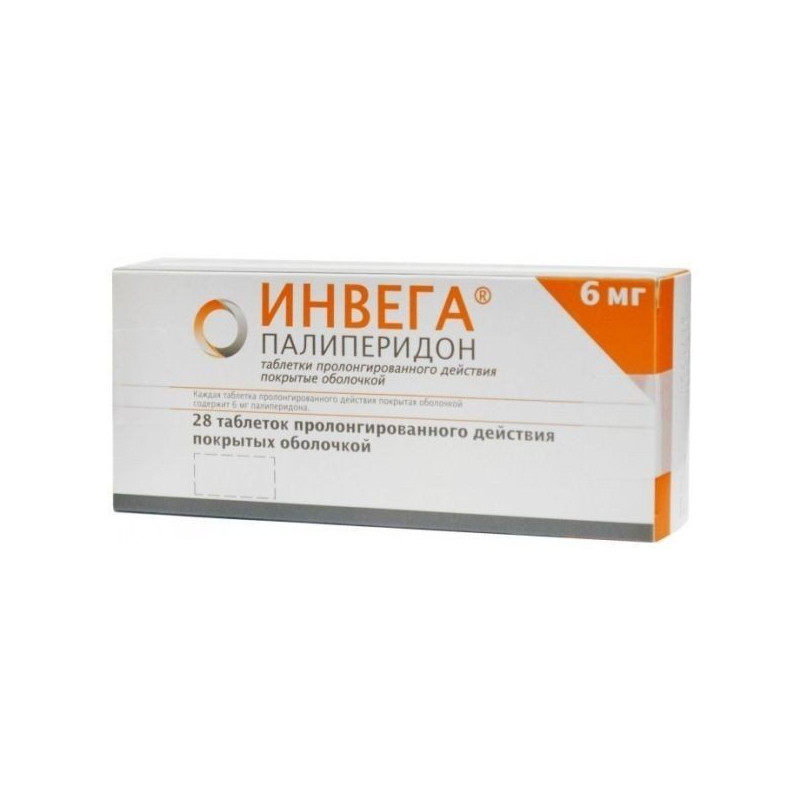



 All payments are encrypted via SSL
All payments are encrypted via SSL
 Full Refund if you haven't received your order
Full Refund if you haven't received your order
INVEGA TAB 6MG №28
Composition and release form:
Tablets of the prolonged action, coated 1 tab.
active substance:
paliperidone 6 mg
excipients: macrogol 200K; macrogol 7000K; sodium chloride; Povidone (C29-32); hyetillosis; stearic acid; butylhydroxytoluene; iron oxide red; macrogol 3350; cellulose acetate (398-10); dye beige (hypromellose, titanium dioxide, polyethylene glycol 400, iron oxide yellow, iron oxide red); carnauba wax
Tablets of the prolonged action, coated, 3 mg, 6 mg, 9 mg and 12 mg.
At 7 tab. in a blister made of aluminum and PVC, laminated with polychlorotrifluoroethylene. 4 or 8 blisters in a carton box.
At 30 tables. in a bottle of high-density PE, with a lid that protects against accidental opening by children. 1 fl. in a carton box.
It is possible to have control of the first opening in the form of a sticker / stickers (on one or 2 sides of a cardboard pack).
Pharmachologic effect:
antipsychotic
Dosage and administration:
Inside, in the morning, regardless of the meal, swallowing whole, squeezed fluid, not chewing, not dividing into pieces, not chopping.
Schizophrenia
The recommended dose is 6 mg 1 time per day. A gradual increase in the initial dose is not required. In some patients, lower or higher doses cause a therapeutic effect within the recommended range of 3–12 mg once a day. There is a general tendency to enhance the effect when using large doses of the drug. If an increase in the dose is necessary, it is recommended to increase the dose by 3 mg / day at intervals of more than 5 days.
Schizoaffective disorders
The recommended dose is 6 mg 1 time per day. A gradual increase in the initial dose is not required. In some patients, lower or higher doses cause a therapeutic effect within the recommended range of 3–12 mg once a day. Increasing the dose, if necessary, should be carried out only after assessing the clinical condition of the patient. If an increase in the dose is necessary, it is recommended to increase the dose by 3 mg / day at intervals of more than 4 days.
Patients with impaired liver function. Patients with a weak or moderate degree of liver dysfunction do not require a dose reduction. Use of the drug Invega&№174; in patients with severely impaired liver function has not been studied.
Patients with impaired renal function. For patients with mild renal impairment (Cl creatinine ≥50, but <80 ml / min), the recommended starting dose is 3 mg 1 time per day. This dose can be increased to 6 mg 1 time per day after assessing the patient's condition and taking into account the tolerance of the drug. For patients with moderate or severe renal impairment (creatinine Cl ≥10, but <50 ml / min), the recommended dose is 3 mg 1 time per day. Use of the drug Invega&№174; in patients with Cl creatinine <10 ml / min has not been studied, and therefore it is not recommended to prescribe the drug to these patients.
Elderly patients. For elderly patients with normal renal function (Cl creatinine ≥80 ml / min), the same doses are recommended as for adult patients with normal renal function. However, in elderly patients, renal function may be reduced, and in this case, the dose of the drug should be selected in accordance with the renal function in a particular patient (see Patients with impaired renal function).
Special patient groups. It is not recommended to change the dose of paliperidone depending on gender, age and on whether the patient smokes or not.
Transfer of patients to treatment with other antipsychotic drugs. Currently, there are no systematically collected data on the transfer of patients from treatment with paliperidone to treatment with other antipsychotic drugs. Pharmacodynamics and pharmacokinetics of different antipsychotic drugs varies, and therefore doctors should closely monitor the condition of patients when transferring them from one antipsychotic drug to another.
